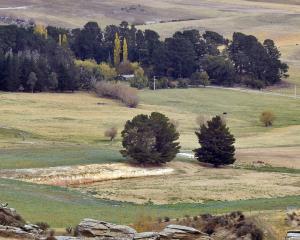
The courtyard looked like something out of a fairytale; the delicate white of the powdered snow offset the dark weathered stone of the tenement beautifully. I decided to venture out into the city centre and do some Christmas shopping.
I wandered slowly through the Christmas market in St Andrew’s Sq, taking care not to slip in the snow. It was a much smaller affair than the market in Princes St Gardens; the St Andrew’s Market was smaller and quainter, more along the lines of a traditional German market than the fairground-esque monstrosity a few streets away.

The Danes have a term — "hygge" — which encapsulates that delicious feeling of warmth and cosiness that comes from snuggling up with a hot water bottle and a cup of cocoa in front of a blazing fire, or hibernating under a hand-crafted patchwork quilt as the rain lashes down outside.
It’s a word that can be used to describe how the Scots embrace the winter months, with their clootie dumplings, hearty stews (I am a newfound fan of cullen skink), scotch broth, and haggis, neeps and tatties. And who can forget the ultimate warming drink — whisky. The Scots do it best, after all.
Local pubs and inns become even more popular during the winter months, acting as refuges from the biting chill. Even my local pub, a less-than-salubrious sports bar with a flat roof, sticky floor, and cracked vinyl barstools, makes an effort, winding (slightly tattered) tinsel around the blackboards and pumping out cheery Christmas tunes at all hours of the day.
Other pubs feature traditional live music, with folk tunes and Gaelic songs filling the room, and if you’re lucky, a roaring open fire and candlelit tables.
Scottish winter traditions hearken back to centuries of rich folklore and ancient customs. Rooted in ancient pagan traditions, Yule was historically celebrated with grand feasts, fire rituals, and ceremonies to mark the cyclical renewal of the year — practices that later evolved into the contemporary festivities of Christmas and Hogmanay.
The winter solstice has been celebrated in Scotland for millennia, with ancient sites like Maeshowe in Orkney perfectly aligning with the solstice sunrise. And then there are tales of Cailleach Bheurra, the divine hag and formidable goddess of winter, whose icy grip shapes the land with her staff, her frosty breath freezing lochs solid and whipping up ice-storms. Brrr.
Winter has its downsides, however. The sun rises extraordinarily late and sets hideously early. Around the winter solstice, which falls around December 21 this year, Scotland sees its shortest days of the year. In Edinburgh, situated at a latitude of 55.95 degrees north, the Sun graces the sky for a mere 6 hours and 57 minutes.
These days, I find myself trudging to work in the dark and then, eight hours later, lumbering home in the dark. My office has no natural lighting and I often feel cooped in, undernourished, and overloaded, like a chook in a battery farm.
I, alongside many Scots, experience Seasonal Affective Disorder (Sad), a type of depression that occurs at certain times of the year, most commonly during the autumn and winter months when daylight hours are shorter. Sad is linked to reduced exposure to natural sunlight, which can disrupt the body’s circadian rhythm and affect serotonin levels. But this year, my Sad hasn’t been too bad.
In rural areas like the Highlands and Islands, winter can be especially challenging, with heavy snowfalls, icy roads and strong winds often isolating these remote communities. Power cuts and transport disruptions are common, and sometimes ferry services are cancelled, leaving islands cut off from the mainland.
Even here in Edinburgh, where the city council is usually on the ball, things can get gnarly; Saturday’s snowfall ground all the city’s buses to a halt, and a great many cars were stuck in the snow and ice.
Even I came a cropper. There was something about the crisp air on Saturday morning that invigorated me, and I set off with a spring in my step and nary a backward glance. This was my first mistake; soon I found myself flat on the snowy pavement, my knee wrenched and my dignity bruised.
I can’t help but wonder if my enjoyment of Scottish winters arise from the fact I experience so little of them. It’s a tradition of mine to return home to Aotearoa for the Christmas holidays — to bask in the sun, splash in the sea, reconnect with old friends, and meet new family members (I have a new niece) for at least a month.
Perhaps if winter was stretching before me, unimpeded and seemingly endless, I’d feel more qualms about the cold and the darkness.
I am, of course, delighted to be heading back to New Zealand for Christmas and New Year, but part of me regrets the fact I cannot partake in Hogmanay traditions with my friends— first-footing, gobbling grapes under the table as the New Year counts down, marvelling at the fireworks and street parades on Princes St.
There’s something so perfect and quintessentially "Christmas" about a winter Christmas — something that doesn’t quite translate to an Antipodean Christmas, with all its sunshine, sand, and summer barbeques.
But at least I’ll be home in Edinburgh for Burns Night on January 25. Last time I danced the night away with my best friends at a ceilidh; next year, I’d like to do the same, perhaps with more haggis and whisky.
Winter in Scotland is a season of contrasts — challenging yet rewarding, harsh yet magical, exhausting yet invigorating.
Scotland’s beloved bard, in his poem Winter: A Dirge, found solace in the tempest’s howl and the desolation of leafless trees. To Burns, the bleakness of winter echoed his own melancholy. But Burns also saw the winter as a reflection of divine will, and he pleaded with his Creator for the strength to endure.
I hope I too can handle the cold and darkness when I return to Scotland in January.
• Jean Balchin is an ODT columnist who has started a new life in Edinburgh.












